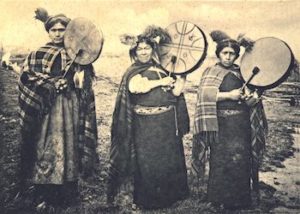
*The Mapuche community is celebrated on this date in 1000. The Mapuche are a group of Indigenous people of present-day south-central Chile and southwestern Argentina, including parts of present-day Patagonia.
The collective term refers to a wide-ranging ethnicity composed of various groups with a typical social, religious, and economic structure and a common linguistic heritage as Mapudungun speakers. Archaeological finds show that Mapuche culture existed in Chile and Argentina from 600 to 500 BC. Genetically, the Mapuche differ from the adjacent indigenous peoples of Patagonia. The Mapuche traditional economy is based on agriculture; their conventional social organization consists of extended families under the direction of a lonko or chief.
In times of war, the Mapuche would unite in larger groupings and elect a Toki (meaning "ax" or "ax-bearer") to lead them. Mapuche material culture is known for its textiles and silverwork. Groups of the Inca Empire reached the Maule River and battled the Mapuche between the Maule and the Itata Rivers. Most modern scholars believe that the southern border of the Inca Empire was situated between Santiago and the Maipo River or somewhere between Santiago and the Maule River.
The Mapuche escaped the Inca rule. Through their contact with Incan invaders, Mapuches would have, for the first time, met people with a state organization. Their contact with the Incas gave them a collective awareness distinguishing between them and the invaders and uniting them into loose geo-political units despite their lack of state organization. When the first Spaniards invaded Chile, the largest indigenous population concentrated from the Itata River to Chiloé Island, the Mapuche heartland. The Mapuche population between the Itata River and Reloncaví Sound was estimated at 705,000–900,000 in the mid-sixteenth century by historian José Bengoa.
The Araucanian Mapuche inhabited the valleys between the Itata and Toltén rivers. South of there, the Huilliche and the Cunco lived as far south as the Chiloé Archipelago. In the seventeenth, eighteenth, and nineteenth centuries, Mapuche groups migrated eastward into the Andes and pampas, fusing and establishing relationships with the Poya and Pehuenche. At about the same time, ethnic groups of the pampa regions, the Puelche, Ranquel, and northern Aonikenk, contacted Mapuche groups. The Tehuelche adopted the Mapuche language and some of their culture in what came to be called Araucanization, during which Patagonia came under effective Mapuche suzerainty. Mapuche in the Spanish-ruled areas, especially the Picunche, mingled with the Spanish during the colonial period, forming a mestizo population that lost its indigenous identity.
But Mapuche society in Araucanía and Patagonia remained independent until the late nineteenth century, when Chile occupied Araucanía and Argentina conquered Puelmapu. Since then, the Mapuche have become subjects, nationals, and citizens of the respective states. Today, the collective group makes up over 80% of the indigenous peoples in Chile and about 9% of the Chilean population. The Mapuche are particularly concentrated in the Araucanía region. Many have migrated from rural areas to the cities of Santiago and Buenos Aires for economic opportunities. Today, many Mapuche and Mapuche communities are engaged in the Mapuche conflict over land and indigenous rights in Argentina and Chile.

Land disputes and violent confrontations continue in some Mapuche areas, particularly in the northern sections of the Araucanía region between and around Traiguén and Lumaco. To defuse tensions, the Commission for Historical Truth and New Treatments issued a report in 2003 calling for drastic changes in Chile's treatment of its Indigenous people, more than 80% of whom are Mapuche. The recommendations included the formal recognition of Indigenous peoples' political and "territorial" rights and efforts to promote their cultural identities.
As late as 2017, Argentine historian Roberto E. Porcel wrote in a communiqué to the National Academy of History that those who often claim to be Mapuches in Argentina would be rather Mestizos, emboldened by European-descent supporters, who "lack any right for their claims and violence, not only for NOT being most of them Araucanians, but also because they [the Araucanians] do not rank among our indigenous peoples."
The 2020 Chilean-Brazilian animated film Nahuel and the Magic Book features characters, Fresia and Huenchur, who represent her clothing attire and her tribe. A video game sequel, Civilization VI, features Lautaro, a young Mapuche toqui known for leading the indigenous resistance against Spanish conquest in Chile and developing the tactics that would continue to be employed by the Mapuche during the long-running ArauIsab. The novel "Inez of My Soul" by Isabel Allende features the conquest of Chile by Pedro Valdivia, and a large part of the book deals with the Mapuche Conflict.